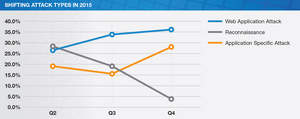OMAHA, NE--(Marketwired - Jan 28, 2016) - Solutionary, an NTT Group security company (
"Threat intelligence is a term that is used loosely today, but one thing the security industry can do to be more effective as a whole, is to better understand and leverage the information that is already at our fingertips," said Rob Kraus, director of research, Security Engineering Research Team, Solutionary. "Shellshock was one of the most pervasive vulnerabilities of the digital era and to this day we continue to find payloads such as BASHLITE actively exploiting these vulnerabilities -- more than a year after the vulnerability was exposed. Until organizations begin to address the complete security lifecycle, breaches will continue to come and go and consumers' loss of faith in businesses will continue to negatively affect brand reputation."
Key Findings:
- Reconnaissance activity plummeted over 77 percent from levels in Q3 '15. When combined with the drop seen in Q3, this is nearly an 88 percent drop in reconnaissance activity from levels in Q2 '15.
- Observed viruses and worms jumped 236 percent during Q4 '15. This type of malware is often indicative that an organization may have been otherwise compromised and infected with a virus or worm to maintain persistence and laterally expand within the targeted environment.
- Shellshock is actively being exploited in 2015, a year and a half after it was exposed. Moreover, over 77 percent of application-specific attacks observed by Solutionary in Q4 targeted the Shellshock vulnerability.
- During 2015, the 130 Android vulnerabilities recorded were more than the previous six years combined. This is cause for concern as more than 76 percent of Android devices are running outdated versions of Android, and nearly 37 percent of all Android devices are running a version of the Android operating system which is more than 26 months old.
- While the total volume of detected malware rose only slightly from Q3 '15, malware from the top five sources (the U.S., China, France, Italy and the U.K.) combined to produce 25 percent more malware than they had during Q3 '15, and accounted for almost 95 percent of malware detected during Q4 '15.
- India entered the top 10 sources of malware with a 221 percent increase in detection. Malware from India included a wide variety of types of malware and targets, including a jump in detections of the MyDoom malware focusing on South Korea and the U.S.
- After the Joomla! vulnerability was announced on December 14, Joomla! exploit attempts were the single most common web application attack for the remainder of Q4 '15.
- Web application attacks retained the top "type of attack" with 41 percent of all attacks during Q4 '15.
To read more key findings from Q4 2015 and to download the full report, please visit: https://www.solutionary.com/threat-intelligence/threat-reports/quarterly-threat-reports/sert-threat-report-q4-2015/
Readers will find several sections in the report providing timely, actionable information that can be used to help protect against today's most malicious attack tactics and vectors.
About Solutionary
Solutionary, an NTT Group Security Company (
Contact Information:
Press Contact:
Edward Fernandez
10Fold for Solutionary
(949) 285-6032
